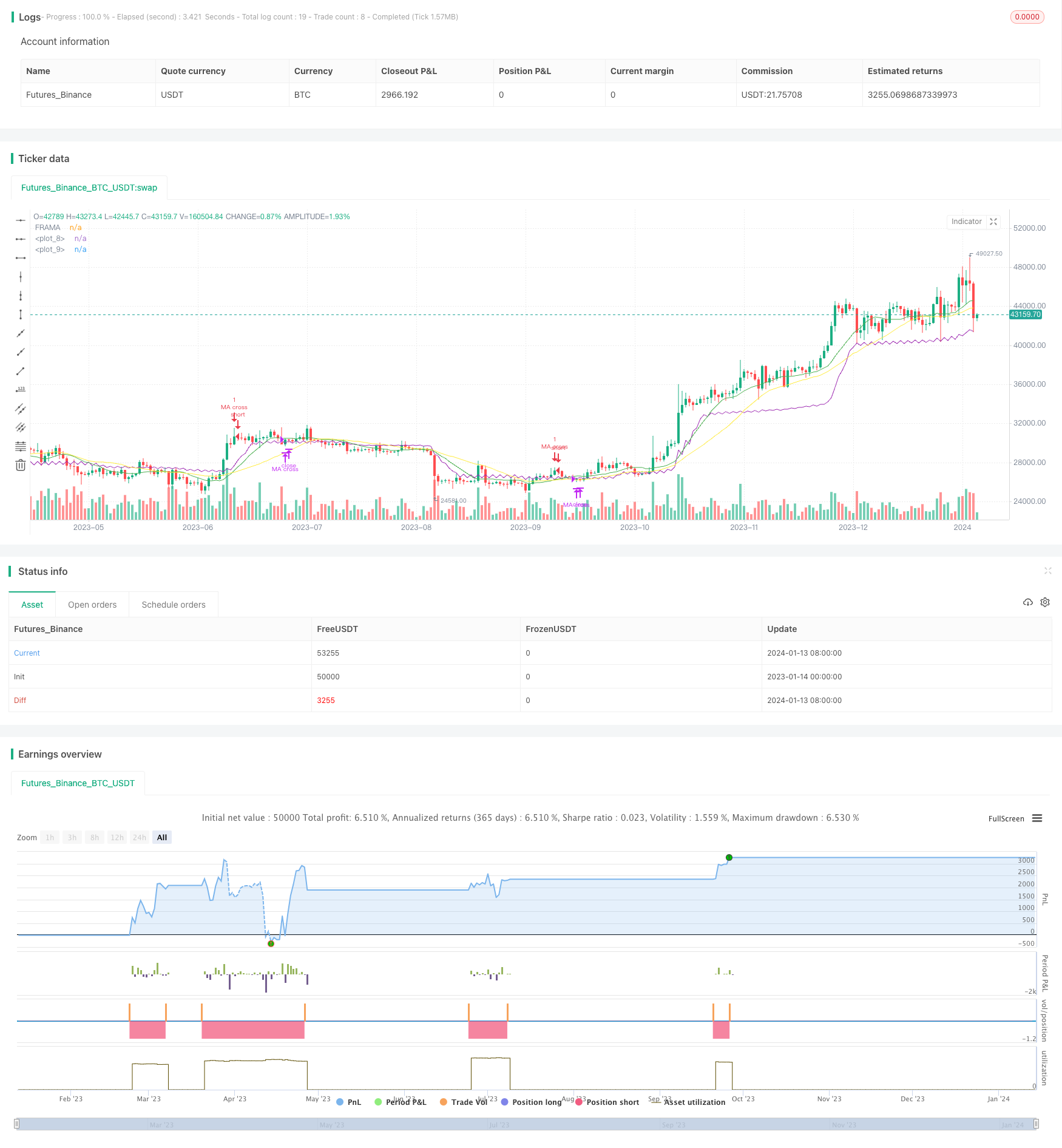FraMA and MA Crossover Trading Strategy Based on FRAMA Indicator
Author: ChaoZhang, Date: 2024-01-15 14:38:48Tags:

Summary
This strategy calculates the fast moving average line ma_fast and slow moving average line ma_slow first, and then combines with the FRAMA adaptive moving average line. It goes long when ma_fast crosses over ma_slow, and closes position when ma_slow crosses below ma_fast or FRAMA falls below close price.
Strategy Logic
-
Calculate the 13-day simple moving average ma_fast and 26-day simple moving average ma_slow.
-
Calculate the FRAMA adaptive moving average line out. The FRAMA formula is complex, the main idea is to dynamically adjust the smoothness α of the moving average based on the highest, lowest and volatility of prices.
-
Go long when ma_fast crosses over ma_slow. This indicates the short-term moving average starts to move up and runs faster than the long-term one, matching the trending characteristics.
-
Close position when ma_slow crosses below ma_fast or FRAMA falls below close price. These indicate trend reversal signals.
Advantage Analysis
-
Combines the advantages of dual moving average system and adaptive moving average system. Dual MA system is good at catching trends, while adaptive MA system filters out noises better.
-
FRAMA indicator automatically adjusts parameters, avoiding the subjectivity of manual parameter tuning.
-
Using two exit signals enables timely catching trend reversals.
Risk Analysis
-
Dual moving average crossovers can have whipsaws, resulting in intermittent losses.
-
Adaptive moving averages introduce more parameters, risking overfitting.
-
Only considers price factors without trading volume filter, hence may miss opportunities.
Optimization
-
Test different MA periods to find the optimal combination.
-
Add volume confirmation to avoid false signals, e.g. requiring volume spikes.
-
Optimize entry and exit rules to make the strategy more robust, e.g. only taking signals in continuation patterns.
Conclusion
This strategy combines dual moving average crossover and FRAMA adaptive moving average, automatically adapting to market conditions by dynamically adjusting parameters. Dual MAs are good at catching trends while FRAMA filters out noises. Using two exit signals also makes the strategy more robust. Next steps could be further parameter optimization and adding volume filter to improve it.
/*backtest
start: 2023-01-14 00:00:00
end: 2024-01-14 00:00:00
period: 1d
basePeriod: 1h
exchanges: [{"eid":"Futures_Binance","currency":"BTC_USDT"}]
*/
//@version=2
strategy("Fractal Adaptive Moving Average",shorttitle="FRAMA",overlay=true)
ma_fast = sma(close,13)
ma_slow = sma(close,26)
plot(ma_fast,color = green)
plot(ma_slow, color = yellow)
price = input(hl2)
len = input(defval=16,minval=1)
FC = input(defval=1,minval=1)
SC = input(defval=198,minval=1)
len1 = len/2
w = log(2/(SC+1))
H1 = highest(high,len1)
L1 = lowest(low,len1)
N1 = (H1-L1)/len1
H2 = highest(high,len)[len1]
L2 = lowest(low,len)[len1]
N2 = (H2-L2)/len1
H3 = highest(high,len)
L3 = lowest(low,len)
N3 = (H3-L3)/len
dimen1 = (log(N1+N2)-log(N3))/log(2)
dimen = iff(N1>0 and N2>0 and N3>0,dimen1,nz(dimen1[1]))
alpha1 = exp(w*(dimen-1))
oldalpha = alpha1>1?1:(alpha1<0.01?0.01:alpha1)
oldN = (2-oldalpha)/oldalpha
N = (((SC-FC)*(oldN-1))/(SC-1))+FC
alpha_ = 2/(N+1)
alpha = alpha_<2/(SC+1)?2/(SC+1):(alpha_>1?1:alpha_)
out = (1-alpha)*nz(out[1]) + alpha*price
plot(out,title="FRAMA",color=purple,transp=0)
entry() => crossover(ma_fast, ma_slow) and (out < close)
exit() => crossover(ma_slow, ma_fast) or crossunder(out, close)
strategy.entry(id= "MA cross", long = true, when = entry())
strategy.close(id= "MA cross", when = exit())
- Multi Timeframe MACD Moving Average Trading Strategy
- ADX Dynamic Trend Strategy
- Trend Following Strategy Based on Hull Moving Average and True Range
- Dual Confirmation Quant Trading Strategy
- Confirmed Divergence Strategy
- Bollinger Wave Strategy
- Myo_LS_D Quantitative Strategy
- Multiplicative Moving Average Dual-direction Trading Strategy
- Donchian Channels Long Term Trend Following Strategy
- IBS and Weekly High Based SP500 Futures Trading Strategy
- Trend Following Strategy Based on SSL Baseline
- Bollinger Bands Trend Following Strategy
- Momentum Trend Following Trading Strategy
- Open Close Cross Moving Average Trend Following Strategy
- Adaptive Trend Following Strategy
- Multi Timeframe RSI Strategy
- Bollinger Bands and K-line Combined Strategy
- Aroon Oscillator Based Stock Trading Strategy
- EintSimple Pullback Strategy
- Polarized Fractal Efficiency (PFE) Trading Strategy